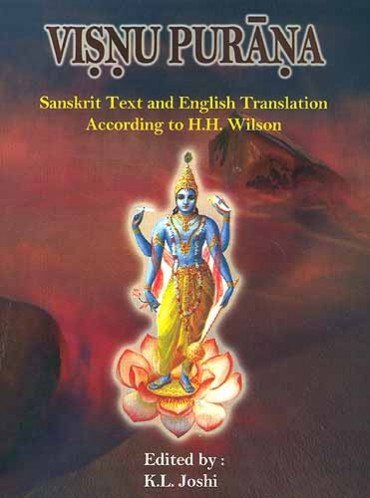The Vishnu Purana
by Horace Hayman Wilson | 1840 | 287,946 words | ISBN-10: 8171102127
The English translation of the Vishnu Purana. This is a primary sacred text of the Vaishnava branch of Hinduism. It is one of the eighteen greater Puranas, a branch of sacred Vedic literature which was first committed to writing during the first millennium of the common era. Like most of the other Puranas, this is a complete narrative from the cr...
13. The Skanda Purāṇa
13. Skanda Purāṇa. “The Skānda Purāṇa is that in which the six-faced deity (Skanda) has related the events of the Tatpuruṣa Kalpa, enlarged with many tales, and subservient to the duties taught by Maheśvara. It is said to contain eighty-one thousand one hundred stanzas: so it is asserted amongst mankind[1].”
It is uniformly agreed that the Skanda Purāṇa in a collective form has no existence; and the fragments in the shape of Saṃhitās, Khaṇḍas, and Māhātmyas, which are affirmed in various parts of India to be portions of the Purāṇa, present a much more formidable mass of stanzas than even the immense number of which it is said to consist. The most celebrated of these portions in Hindustan is the Kāśī Khaṇḍa, a very minute description of the temples of Śiva in or adjacent to Benares, mixed with directions for worshipping Maheśvara, and a great variety of legends explanatory of its merits, and of the holiness of Kāśī: many of them are puerile and uninteresting, but some are of a higher character. The story of Agastya records probably, in a legendary style, the propagation of Hinduism in the south of India: and in the history of Divodāsa, king of Kāśī, we have an embellished tradition of the temporary depression of the worship of Śiva, even in its metropolis, before the ascendancy of the followers of Buddha[2], There is every reason to believe the greater part of the contents of the Kāśī Khaṇḍa anterior to the first attack upon Benares by Mahmud of Ghizni. The Kāśī Khaṇḍa alone contains fifteen thousand stanzas.
Another considerable work ascribed in upper India to the Skanda Purāṇa is the Utkala Khaṇḍa, giving an account of the holiness of Urissa, and the Kṣetra of Puruṣottama or Jagannātha. The same vicinage is the site of temples, once of great magnificence and extent, dedicated to Śiva, as Bhuvaneśvara, which forms an excuse for attaching an account of a Vaiṣṇava Tīrtha to an eminently Śaiva Purāṇa. There can be little doubt, however, that the Utkala Khaṇḍa is unwarrantably included amongst the progeny of the parent work. Besides these, there is a Brahmottara Khaṇḍa, a Revā Khaṇḍa, a Śiva Rahasya Khaṇḍa, a Himavat Khaṇḍa, and others. Of the Saṃhitās, the chief are the Sūta Saṃhitā, Sanatkumāra Saṃhitā, Saura Saṃhitā, and Kapila Saṃhitā: there are several other works denominated Saṃhitās. The Māhātmyas are more numerous still[3]. According to the Sūta Saṃhitā, as quoted by Col. Vans Kennedy[4], the Skanda Purāṇa contains six Saṃhitās, five hundred Khaṇḍas, and five hundred thousand stanzas; more than is even attributed to all the Purāṇas. He thinks, judging from internal evidence, that all the Khaṇḍas and Saṃhitās may be admitted to be genuine, though the Māhātmyas have rather a questionable appearance. Now one kind of internal evidence is the quantity; and as no more than eighty-one thousand one hundred stanzas have ever been claimed for it, all in excess above that amount must be questionable. But many of the Khaṇḍas, the Kāśī Khaṇḍa for instance, are quite as local as the Māhātmyas, being legendary stories relating to the erection and sanctity of certain temples or groups of temples, and to certain Liṅgas; the interested origin of which renders them very reasonably objects of suspicion. In the present state of our acquaintance with the reputed portions of the Skanda Purāṇa, my own views of their authenticity are so opposed to those entertained by Col. Vans Kennedy, that instead of admitting all the Saṃhitās and Khaṇḍas to be genuine, I doubt if any one of them was ever a part of the Skanda Purāṇa.
Footnotes and references:
[1]:

Click to view
[2]:
The legend is translated by Col. Vans Kennedy: Ancient and Hindu Mythology, Appendix B.
[3]:
p. xlvi In a list of reputed portions of the Skanda Purāṇa in the possession of my friend Mr. C. P. Brown, of the Civil service of Madras, the Sanhitās are seven, the Khaṇḍas twelve, besides parts denominated p. xlvii Gītā, Kalpa, Stotra, &c. In the collection of Col. Mackenzie, amongst the Māhātmyas thirty-six are said to belong to the Skanda P.: vol. I. p. 6i. In the library at the India House are two Sanhitās, the Sūta and Sanatkumāra, fourteen Khaṇḍas, and twelve Māhātmyas.
[4]:
Ancient and Hindu Mythol., p. 554, note.
